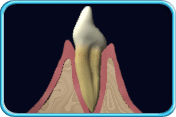Clean the teeth
In order to clean the teeth effectively, you have to thoroughly remove the dental
plaque that adheres on the tooth surfaces, false teeth and orthodontic appliances.
The accumulation of plaque will cause
Dental Caries and Periodontal Disease.
Clean the tooth surfaces by toothbrushing
Toothbrushing can remove dental plaque on tooth surfaces. We should brush our teeth
in the morning and before bed at night everyday. Thorough removal of plaque can
prevent Periodontal Disease.
Place the toothbrush at an angle towards the gingival margin
The head of the toothbrush should be placed with the tips of the bristles tilted
at an angle towards the gingival (gum) sulcus at the gingival margin where plaque
tends to accumulate.
 Dental plaque accumulates in the sulcus at the gingival margin
Dental plaque accumulates in the sulcus at the gingival margin
|
 Place the tips of the bristles tilted at an angle towards the gingival margin
Place the tips of the bristles tilted at an angle towards the gingival margin
|
Brush the teeth systematically
|
|
1. Firstly, brush the outer surfaces of the upper and lower teeth. The head of the
toothbrush should be placed with the tips of the bristles tilted at an angle towards
the gingival margin. Gently move the toothbrush in small scrubbing motion, working
on two to three teeth at a time.
|
|
FAIL (the browser should render some flash content, not this).
|
2. Then brush the inner surfaces of teeth in the same way as brushing the outer
surfaces.
|
|
FAIL (the browser should render some flash content, not this).
|
3. When we brush the inner surfaces of front teeth, we should hold the toothbrush
upright using gentle motion scrubbing from the gingival margin towards the crowns
of the teeth.
|
|
FAIL (the browser should render some flash content, not this).
|
4. Finally, brush the chewing surfaces of the teeth with the toothbrush moving backward
and forward.
|
Video display: Toothbrushing Method
Points to note
• Even if you have grasped the toothbrushing technique, it is important to
use appropriate toothbrush and
toothpaste.
• Toothbrushing cannot remove plaque from the adjacent tooth surfaces. They
have to be cleaned by dental floss or
floss holder.
• The order of brushing and flossing does not affect the effectiveness of tooth
cleaning. As long as we use the correct technique, we can achieve satisfactory results.
Solutions to common problems encountered during toothbrushing
• Areas that are hard to reach by a toothbrush are difficult to be cleaned
by toothbrushing. For example, the inner surfaces of lower teeth or crooked teeth:
The solution is to clean with a small head toothbrush or a
single-tuft toothbrush.
• Gagging when brushing:
Some people may gag when they brush their teeth. To improve this situation, you
can choose to use a toothbrush with a small head.
• Gingivae bleeds and hurts when brushing:
The accumulation of dental plaque causes gingival inflammation. In that case, the
gingivae (gum) will bleed when brushing. You can choose to use a soft toothbrush
to clean away the plaque in such areas. Gingival inflammation will slowly subside
and the gingivae will become healthy when the oral hygiene has improved.